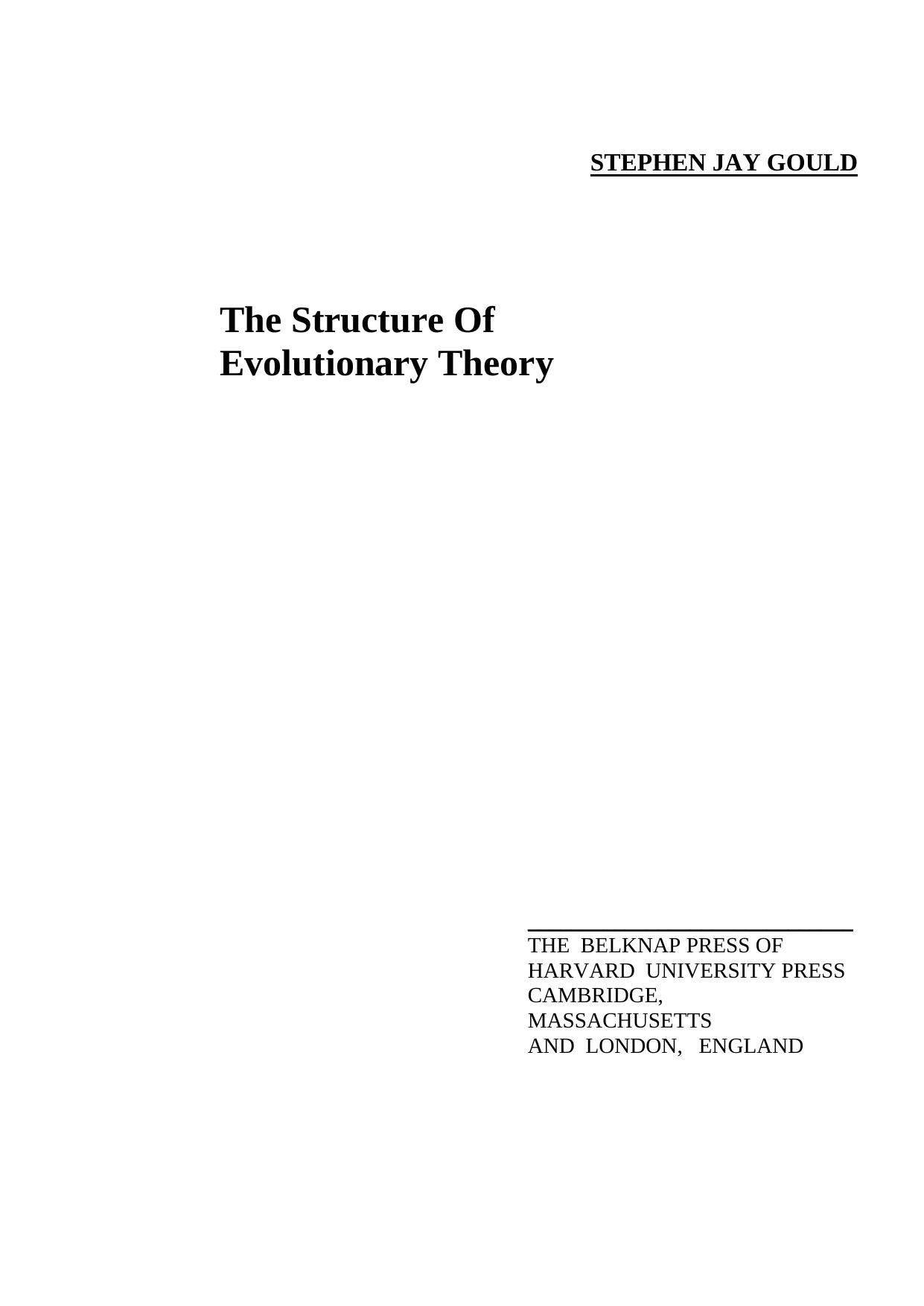The Structure of Evolutionary Theory by Stephen Jay Gould

Author:Stephen Jay Gould [Gould, Stephen Jay]
Language: eng
Format: epub, pdf
Tags: Ensayo, Ciencias naturales
Publisher: ePubLibre
Published: 2002-01-01T05:00:00+00:00
Criteria for individuality
Moving to the second category of criteria for individuality (see pp. 602-613 of this chapter), we may regard the species-level analogs of organismal birth and death (lines III—2)—speciation and extinction—as both evident and well recognized. But the different causes of cohesion (line 113) are both fascinating and portentous throughout the chart. I only remind readers that the mechanisms used by species, while not clamping down so hard on lower levels, and therefore providing substantial “play” for interaction between organismal and species selection, provide species with as much coherence and stability as the “standard” devices of morphological boundaries, internal policing and functional integration among parts, do for organisms.
Important differences arise in the mode of production for novel variation in newborn individuals. Mutation supplies this attribute at the organismal level. (Following conventional usage, I consider recombination in sexual organisms as a device for spreading variation among individuals, although I recognize, of course, that novel combinations also arise thereby. In asexual organisms, a better analog for species in any case, mutation alone supplies new variation.) Speciation itself is not the proper analog of mutation at the species level (an error previously made both by me, in Gould and Eldredge, 1977, and by Stanley, 1975). Speciation, the production of a new species-individual by budding, is the analog of organismal birth, particularly the birth of asexual organisms. We made this error by inadequately interpreting one of the most interesting differences between organisms and species as evolutionary individuals. The birth of a new organism, particularly in asexuals, may or may not engender any substantial difference from parental form or genetics. But the birth of a new species necessarily includes the generation of enough difference from ancestors to preclude reproductive amalgation between the parts (organisms) of the two species. We therefore mistook a forced correlate of birth at the species level (change at speciation) with the process of birth itself (speciation)—and equated the correlate at one level with the phenomenon at the other. The proper analog of mutation, a source of variation for new individuals, is the change that insures reproductive isolation between species (with geographic isolation as a usual precondition, and drift and selection as mechanisms)—see line 115.
This difference underlies the two important disparities listed as lines II4a and II5a—one favoring the evolutionary capacity of organisms, the other of species. Sexual organisms can spread favorable variation to other individuals in the collectivity by recombination. But the favorable features of new species remain stuck in the species and its lineal descendants, and cannot be spread to other species in the clade—except in the infrequent circumstance of hybridization among species in a clade of multicellular forms. (By contrast, lateral transfer seems to be common in the evolution of prokaryotic lineages.) This preclusion of lateral spread puts a strong damper upon evolution within clades. The same limitation, of course, affects asexual vs. sexual organisms—and represents a standard argument for the great advantage of sex, and its evolutionary prevalence, in complex metazoans (Williams, 1975; Maynard Smith, 1978).
Species do
Download
The Structure of Evolutionary Theory by Stephen Jay Gould.pdf
This site does not store any files on its server. We only index and link to content provided by other sites. Please contact the content providers to delete copyright contents if any and email us, we'll remove relevant links or contents immediately.
Periodization Training for Sports by Tudor Bompa(8097)
The Body: A Guide for Occupants by Bill Bryson(4887)
The MacArthur Bible Commentary by John MacArthur(4682)
The Sports Rules Book by Human Kinetics(4216)
What It Really Takes to Get Into Ivy League and Other Highly Selective Colleges by Hughes Chuck(3644)
Marijuana Grower's Handbook by Ed Rosenthal(3585)
The Sprouting Book by Ann Wigmore(3510)
The Martian by Andy Weir(3250)
Salt, Fat, Acid, Heat: Mastering the Elements of Good Cooking by Nosrat Samin(3078)
The Bread Bible by Rose Levy Beranbaum(2969)
Sapiens and Homo Deus by Yuval Noah Harari(2944)
Harry Potter 4 - Harry Potter and The Goblet of Fire by J.K.Rowling(2942)
Classic by Mary Berry(2916)
The Marketing Plan Handbook: Develop Big-Picture Marketing Plans for Pennies on the Dollar by Robert W. Bly(2903)
Martha Stewart's Baking Handbook by Martha Stewart(2748)
The Plant Paradox by Dr. Steven R. Gundry M.D(2512)
Screenplay: The Foundations of Screenwriting by Syd Field(2505)
50 Economics Classics by Tom Butler-Bowdon(2484)
The Cambridge Grammar Of The English Language by Rodney Huddleston Geoffrey K. Pullum(2355)
